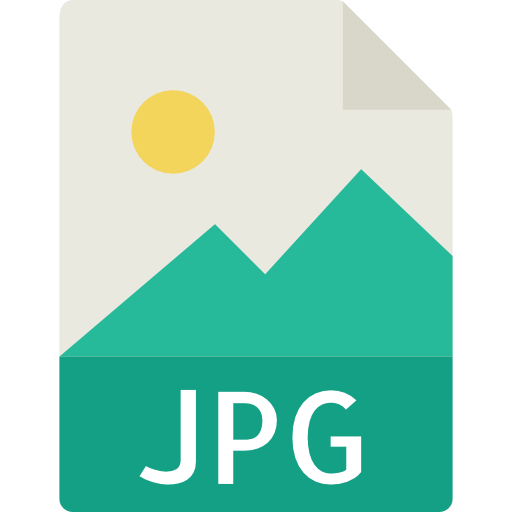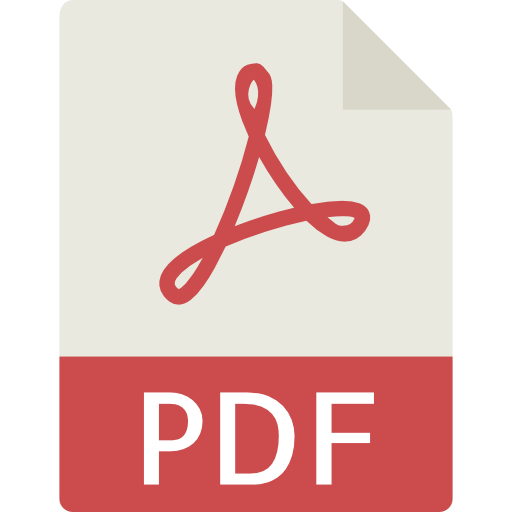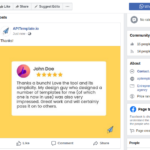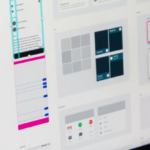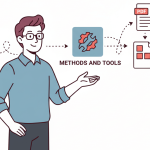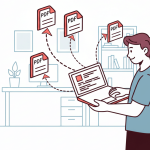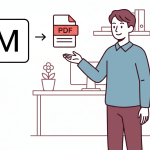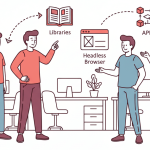Creating documents is a common need in almost every system, whether it is invoices in an online store, reports in a business tool, or contracts in an enterprise app. When the number of documents grows, creating documents manually or without a proper system becomes slow, error-prone, and hard to manage.
That is why, for developers, the PDF generation process is so important.

It provides a way to take raw data, place it into templates, and automatically produce files that look the same on every device and can be shared or stored safely.
This article is a complete guide to the PDF generation process for developers. It explains what the process means, why it matters, the tools available, common challenges, real-life examples, and step-by-step methods to generate PDFs efficiently.
What Is the PDF Generation Process?
The PDF generation process is the method of creating a PDF file using data and templates through code or tools. Instead of writing a document by hand, developers use libraries, scripts, or APIs to build a PDF automatically.
The output of this process is a file that looks the same on any device and can be shared, stored, or printed easily.
Why the PDF Generation Process Matters for Developers
Daily, developers need to generate documents that are fast, accurate, and scalable. Doing this manually takes extra time and often leads to mistakes. The PDF generation process makes document creation easier by automating tasks, keeping layouts consistent, and handling large amounts of data.
Below are the main reasons why this process matters.
- Automation of repetitive tasks: Developers can integrate PDF generation into applications so that documents like invoices or receipts are created automatically. This removes the need for manual document creation and ensures consistency at scale.
- Dynamic data handling: PDFs can be populated directly with data from databases or APIs. This allows developers to generate personalized documents for thousands of users, all based on live data.
- Control over layout and design: With templates and styling tools like HTML and CSS, developers can decide exactly how a document should look. This ensures brand consistency and helps when strict formatting rules are required, such as in financial or legal documents.
- Integration into workflows: PDF generation can be connected to wider workflows through APIs or automation platforms. For example, a purchase in an e-commerce system can trigger a PDF invoice that is sent immediately to the customer.
- Scalability and performance: Developers need solutions that handle high volumes of requests without slowing down. A proper PDF generation process can manage thousands of documents per hour while keeping performance stable.
- Advanced features for business needs: Developers can add features like tables, charts, headers, and footers. These are important for reports, analytics, and documents where structure and readability are critical.
By implementing a robust PDF generation process, developers can significantly improve their applications efficiency, reduce manual errors, and deliver professional-quality documents that meet both user expectations and business requirements.
Common Examples of PDF Generation
PDF generation is not limited to one type of document. Developers use it in many real-world situations where accuracy and speed are important. From business transactions to education and travel, the process helps create files that are consistent and ready to use.
Below are some common examples where PDF generation makes a clear difference.
- Invoices and receipts: Businesses often need to send invoices or receipts after a purchase. Doing this by hand takes time and can lead to mistakes. With automated PDF generation, the document is created instantly, and the customer receives it right away.
- Certificates and reports: Schools, training platforms, and workplaces issue certificates and reports regularly. By designing one template, developers can let the system fill in names, dates, and other details. This makes it possible to generate hundreds of documents quickly without manual work.
- Bank statements and contracts: Financial institutions generate monthly statements, and legal teams prepare contracts that must stay consistent. PDF generation ensures every document follows the same layout and is delivered on schedule. Developers can scale this process to thousands of files at once.
- Tickets and passes: Event organizers, airlines, and transport companies issue tickets or boarding passes with personal details like names and seat numbers. PDF generation makes it possible to create unique documents for every customer instantly. This keeps the process smooth and avoids delays.
- Product catalogs and brochures: E-commerce platforms and marketing teams create product catalogs with images, descriptions, and pricing. PDF generation allows them to produce professional-looking catalogs that can be easily shared with customers or printed for offline distribution.\n*
- Medical reports and prescriptions: Healthcare providers generate patient reports, lab results, and prescriptions that require precise formatting and patient confidentiality. Automated PDF generation ensures consistent medical documentation while maintaining security standards.
- Insurance policies and claims: Insurance companies process thousands of policies and claims documents daily. PDF generation helps create standardized documents with policy details, terms, and conditions, reducing processing time and ensuring compliance with regulations.
- Real estate listings and contracts: Real estate agencies generate property listings with photos, descriptions, and pricing details. PDF generation enables them to create professional marketing materials and legal documents like purchase agreements efficiently.
- Shipping labels and manifests: Logistics companies create shipping labels, packing slips, and delivery manifests for thousands of packages daily. Automated PDF generation ensures accurate labeling and helps streamline the shipping process.
- Survey reports and analytics: Market research firms and data analysts generate comprehensive reports with charts, graphs, and statistical data. PDF generation helps present complex data in a professional, readable format for clients and stakeholders.
These examples show how PDF generation touches nearly every industry and use case. Whether it is handling financial transactions, managing educational records, or streamlining business operations, the ability to generate professional documents automatically is essential for modern applications.
How the PDF Generation Process Works for Developers
Every PDF begins with data. This data can include customer details, product lists, prices, or images like company logos. Developers usually collect data from a database or receive it through an API. Without this data, a PDF document has no meaningful content to present.
Next comes the template. A template defines the structure and layout of the document. Developers often design templates with HTML and CSS, since these are flexible and familiar from web design. A well-structured template ensures that the final PDF is consistent, whether you are generating one file or thousands.
After the template is ready, the system fills it with data. This process connects the raw data with placeholders in the template. For example, instead of typing each customer’s name and address into an invoice, the system inserts this information automatically. This makes the process fast and avoids human error.
Once the data is in place, the content must be converted into PDF format. This step ensures that fonts, images, and layouts are preserved and look the same across all devices.
Developers rely on libraries or APIs for this task, as they handle the technical details of the conversion.
Finally, the PDF is delivered to the user. This could mean letting someone download it directly, sending it by email, or saving it in cloud storage. In automated workflows, this happens without manual effort; for example, an online store can email a PDF receipt to a customer seconds after checkout.
Tools Developers Use for PDF Generation
Developers have different options for generating PDFs, and the choice often depends on the programming language they are working with.
For instance, in JavaScript, developers can use libraries to create or convert documents directly in web applications. This is useful because many modern applications are browser-based, and JavaScript makes it possible to generate PDFs on the client side or through server scripts. Learn more in our guide to generating PDFs in JavaScript.
In Python, developers rely on libraries that allow them to build PDFs programmatically. These are important in data-heavy applications, like finance or analytics, where you need to produce detailed reports in bulk.
By writing simple scripts, developers can generate hundreds or even thousands of documents at once. See our article to converting HTML to PDF in Python for more details.
For Java or C#, PDF generation libraries integrate into larger enterprise systems. These languages are often used in banking, healthcare, or government software, where documents like statements, contracts, and forms must follow strict formatting rules.
Using built-in libraries ensures accuracy and reliability across these complex systems. See our guide to converting HTML to PDF in Java and our guide to converting HTML to PDF in C# for more details.
Another popular approach is using HTML and CSS to design templates and then converting them into PDFs. This is important because many developers already know web technologies, so they don’t have to learn something new.
With HTML templates, you can design invoices, reports, or certificates that look exactly like web pages and then generate PDFs from them.
Some developers prefer to use API-based PDF generation. Instead of managing all the code themselves, they connect to a service that handles the heavy lifting.
APITemplate.io is one example that makes this simple. You design a template once, send your data to the API, and instantly get a finished PDF. This approach is important for teams that want scalability and automation without spending time maintaining their own PDF libraries.
Each of these approaches has its own importance. If you want to explore the pros and cons of libraries, headless browsers, and APIs in more detail, see our guide to HTML to PDF conversion methods.
- Direct libraries give full control over your code.
- HTML-to-PDF methods give design flexibility using familiar web skills.
- APIs make the process faster and more scalable.
Developers choose the tool that matches their skills, project requirements, and the scale of documents they need to produce.
PDF Generation Steps with APITemplate.io
APITemplate.io is an API service for generating PDFs and images from reusable templates. It supports both a visual editor and an HTML editor, so you can design templates with or without code.
Developers can integrate it with tools like Zapier, Make.com, or directly through REST API to automate document creation. You can get started with PDF generation for FREE and upgrade as your needs grow.
Building and maintaining your own PDF generation system can be complex. Developers often spend time fixing layouts, handling large data, and solving formatting issues.
A tool like APITemplate.io makes this easier by giving you control over templates while saving time and reducing errors. It allows you to focus on your application while the PDF generation process runs smoothly in the background.
Step 1: Register for a Free Account
You start by signing up on APITemplate.io and creating a free account. No credit card is needed, and with the free plan, you can generate up to 50 PDFs every month.
That’s enough to test things out and see how the process works in practice. You can get started for free and upgrade as you grow
This step is important because it lets you get hands-on right away without any upfront cost.
For example, if you run a small shop and want to try automating invoices, you can do it safely on the free plan. Later, as your needs grow, you can always upgrade.
Step 2: Create PDF Templates with the Visual Editor
Once you’ve registered, you move on to building a template. With the WYSIWYG editor, you design by dragging and placing elements on the page. It’s like working in a word processor; no coding needed. You can set up layouts for things like invoices, certificates, or reports.
The real value here is that your template is reusable. Imagine you run a school and need to generate hundreds of student certificates.
You only design the template once, and after that, the system fills in each student’s name and details automatically. This saves hours of repetitive work.

Besides using visual editor, there are additional ways to generate PDF from HTML.
One option is to use HTML, CSS, and JavaScript. This gives you full control over the layout and styling, and you can even connect it with JSON data so the content updates automatically. We offer an API to convert HTML string to PDF and you can find out more at https://apitemplate.io/apiv2/#tag/API-Integration/operation/create-pdf-from-html
Another option is to generate PDFs directly from a webpage URL. This is useful when your content is already online, like a report or a dashboard, and you just need to convert it into a clean PDF version. We also offer an API to convert PDF from a URL: https://apitemplate.io/apiv2/#tag/API-Integration/operation/create-pdf-from-url
Step 3: Automate and Integrate with Workflows
Once your templates are ready, you can connect APITemplate.io with your existing workflow. It integrates with popular tools like Zapier, Make.com, and Airtable. You can also use the REST API directly if you want more control.
This step is powerful because it saves you from creating each PDF manually. Think of an online store: every time someone makes a purchase, the system can automatically generate and send an invoice. You set up the connection once, and after that, it runs on its own.
Step 4: Generate and Download the Final PDF
The last step is sending your data to the template so the PDF can be created. You can provide the data as JSON or as key-value pairs, and the system will fill in the template with the right information. Once the PDF is generated, you can download it, store it, or share it.
This is where everything comes together. Imagine you’re managing an event and need to issue tickets to attendees.
Instead of designing each one by hand, you feed the list of names into the system, and in minutes, everyone has their personalized ticket ready.
Challenges in PDF Generation
When generating PDFs at scale, developers often run into challenges that affect how documents look, perform, and stay secure.
Small issues like page breaks or font rendering can create bigger problems when you’re producing hundreds or thousands of files. It’s important to understand these common challenges so you can prepare solutions early and avoid wasting time later.
i. Layout and formatting issues
One common challenge in PDF generation is keeping the layout consistent. Sometimes tables break across pages, or text does not align the way you planned. This can make the final document look messy and unprofessional. For businesses, this means more time fixing errors instead of focusing on work.
The solution is to use templates that handle margins, page breaks, and headers in advance. Tools like APITemplate.io offer preview features so you can test and adjust before sending the document out.
ii. Fonts and multiple languages
Another challenge is working with different fonts and scripts. PDFs that look fine in English may fail when you switch to languages like Arabic, Chinese, or Hindi.
Text may not display properly, or fonts may not match the brand style. This can make your document hard to read for users.
To solve this, you need to use Unicode-supported fonts and check language rendering during design. APITemplate.io supports custom CSS and JavaScript, which helps you style and adjust your documents for different needs.
iii. File size and performance
PDFs can become very large when they include many images or complex designs. Large files take longer to generate and can be slow to download.
This can frustrate end users and also slow down automated workflows. In some cases, it can even cause storage issues.
The solution is to optimize images, use compression, and keep layouts simple where possible. Most PDF generation tools also support options to reduce file size while keeping quality acceptable.
iv. Security and access control
PDFs often contain sensitive information like invoices, contracts, or personal records. If these documents are shared without protection, they can be copied, altered, or sent to the wrong people. This can put your business at risk of data leaks or misuse.
A good way to solve this is to use password protection, watermarks, or access restrictions when creating PDFs.
In short, PDF generation is powerful but comes with its own set of hurdles. Layout problems, font compatibility, large file sizes, and security concerns are issues every developer should watch for.
By using the right templates, optimizing resources, and applying safeguards, you can make sure your PDFs remain consistent, efficient, and secure across all use cases.
FAQ
1. What is the PDF generation process for developers?
The PDF generation process is the method of creating a PDF file automatically with code or tools. Developers use data and templates to build documents that keep the same look across all devices.
2. How can developers automate PDF creation in their applications?
Developers can connect PDF generation to workflows so documents are created when certain actions happen. For example, a system can create an invoice right after a purchase without manual work. APITemplate.io supports REST API and integration with no-code/low-code platforms such as Zapier, Make.com, Bubble. Developer can use either of the integrations above to generate PDF documents.
3. What are the common programming tools used for generating PDFs?
Developers often use libraries in languages like JavaScript, Python, Java, or PHP. These libraries provide functions to design layouts, insert data, and convert content into PDF format.
4. How do developers design PDF templates with HTML and CSS?
A developer can write a template in HTML and style it with CSS, just like a web page. This template is then converted into a PDF so it keeps the same design and layout.
5. What are best practices for scalable and reliable PDF generation?
Keep templates simple and consistent, optimize images to reduce file size, and test layouts before sending. Developers should also ensure the process can handle many documents at once without slowing down.
Conclusion
The PDF generation process gives developers a reliable way to create documents automatically. It starts with data, moves through templates, and ends with a file that can be shared or stored without changes in format.
By using the right tools, developers can handle tasks like invoices, reports, or contracts at scale. This makes the PDF generation process an important part of development work.
